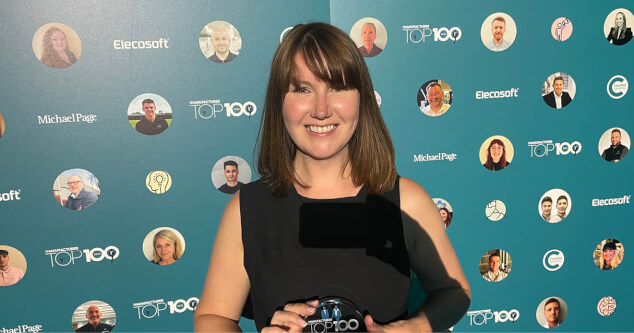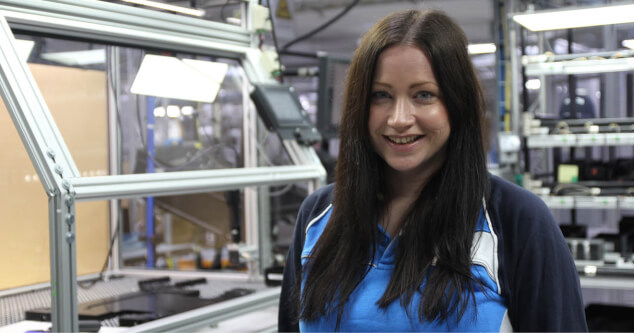Industrial automation and robotics: still a man’s world?
Publicerat 7 februari 2024 i Sustainable Manufacturing
What is it like being a woman in automation today? Three women from OMRON Europe talk about their experiences in the world of industrial automation, the challenges they face, and the tools and support that have helped them to thrive.
When Wendy Tonks first started her career in engineering in the UK just over 20 years ago, one of the first ground rules that she had to lay down was that she wasn’t a tea lady.

“I was in my twenties, the only female in a team of mainly ex-naval guys in their forties, which made life interesting. There were jokes and there was an assumption that I would make the tea. I always said no because I thought it was important to set that boundary from the outset,” she says.
It took a couple of years for her male colleagues to accept her as an equal.
“I had to build that trust and prove that I was capable,” she recalls.
Fast forward two decades and thankfully Wendy doesn’t have to contend with misogynistic attitudes in the workplace. She is Lead System Test Engineer at OMRON Europe working within the company’s Netherlands-based R&D team, which includes hardware and software engineers, data scientists, testers and mechanical engineers. A quarter of her colleagues are female.
“We have women working in all areas of R&D in The Netherlands and it is fantastic. I love the fact we have this diverse team as it results in different ways of thinking, which can be really helpful when solving problems,” she says.
Still in the minority
However, outside of the workplace, when Wendy attends industry events and conferences, she says that as a woman in automation R&D, she is still viewed as something of an anomaly.
“There tend to be very few women presenting on technical subjects and it is often remarked on during conversations. People say things like ‘Oh, you’re the first woman I’ve spoken to today’.”
This anecdotal evidence that women are still underrepresented in tech and engineering roles is backed up by numerous data sources. McKinsey and Eightfold AI analysis of the European workforce in 2022 found that women occupy only 22 per cent of all tech roles in European companies.
One of the biggest problems of being in the minority is the sense of isolation it can create.
“For a very long period during my early career I couldn’t talk about how it felt as all my friends were working in areas like accountancy and travel, which were very different worlds to engineering. Now, I seek out that camaraderie and community and attend events that give women a platform for presenting and discussing their ideas. Next week I am going to an event for women in cybersecurity, for example. I think these industry gatherings promote a sense of community, so women know that they're not isolated,” says Wendy.
Lonely at the top
The isolation often gets greater the higher up the ladder women climb, as only a very small percentage make it to senior level. In the c-suite at European tech companies, only one in seven executives are women, according to data from Figures.

Philippa Glover is a mother of two and member of OMRON’s UK and Ireland Senior Leadership Team. She says that during the early part of her career she never saw herself as a ‘woman in industry’; it was only after she had her children and became more exposed to the c-suite that she realised she was often the only woman in the room.
“The current reality is that, unfortunately, there aren’t always other women in the room. That can be uncomfortable and so we need to create a supportive environment. Having safe spaces to talk about positive experiences and challenges encountered is a huge part of that.”
The importance of allyship
She continues: “I am a passionate advocate of allyship; I have a fantastic peer-group of leaders - both men and women - who have supported, championed and - more importantly - challenged me to reach the point I am at and who will continue to do that to ensure I reach my potential and build a rewarding and successful career.”
Alongside allyship, mentoring and coaching is another form of support that can be invaluable for women in senior roles. As Team Lead for IPC, HMI & Robotics at OMRON’s North Brabant factory in The Netherlands, 31-year old Iris Brem oversees a team of 26 factory floor personnel.

A young manager from a technical background, she has found people management and motivation one of the most challenging aspects of her role. To support her in her own development and decision making, Iris asked the site’s former logistics manager - a colleague she admired and looked up to - to be her coach.
“Every month we sit together and discuss the challenges I have come against. She helps me to tackle those challenges and gives me advice. Talking it through helps and I find the way she manages people extremely inspiring,” says Iris.
New working patterns promote equality
Iris is also of the view that as employers embrace more flexible working practices, some of the practical barriers that have historically prevented women from moving into more senior roles are being removed.
“A 40-hour working week is far less common than it was as people strive for a better work-life balance, also childcare is being split more evenly between parents and companies are more open to hybrid and part-time working. With these changes, I think we should be able to reverse the trend of too few women building careers in technology,” says Iris.
But even though, from a practical perspective, it is easier for women today to juggle work and caregiving, a lack of confidence and self belief can still thwart progression.
“I have girls in my team who have ambition but not confidence. I work with them on development plans as I really want to encourage more women to achieve their career ambitions. I feel sometimes women need to be encouraged to believe in themselves.”
She says that the non-hierarchical structure and inclusive ethos at OMRON helps in this respect.
“At OMRON, we have 26 different nationalities. Men and women are treated the same. Everyone is seen as equal.”
Take a look in our blog for other parts in our ‘women in automation’ series of articles, for example looking at what needs to be done to attract more females into automation.
Read our other Sustainable Manufacturing blogs